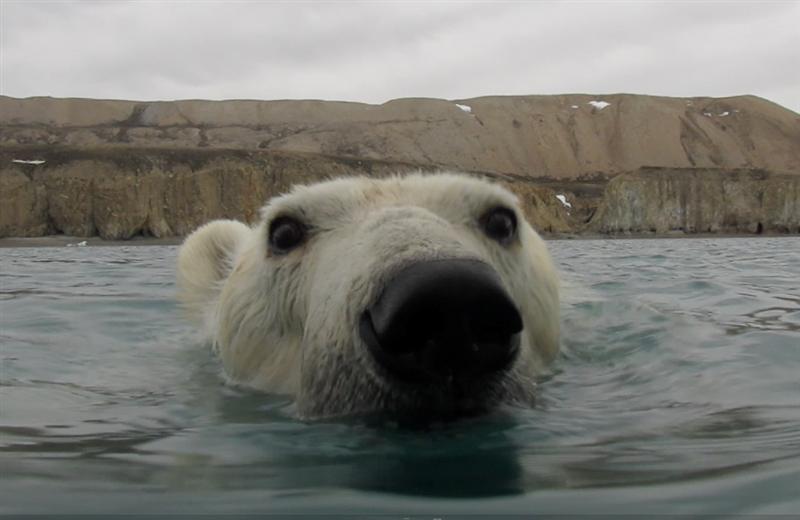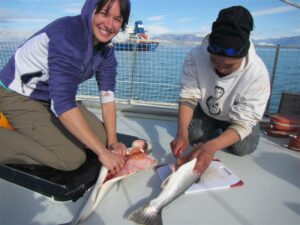
Our favourite moment: When we had an extremely inquisitive polar bear swimming around the boat while anchored at Bylot Island. That was a very special moment that had all aboard spellbound. Photo: Pascale Otis / Students on Ice
Arctic Tern I is a polar expedition vessel acquired by the Students on Ice Foundation in partnership with WWF to provide a safe, environmentally friendly, cost effective, and versatile platform for education, research and media projects in the Arctic. In summer 2013, Arctic Tern I headed to the eastern Canadian Arctic and on the first of a five-year mission to assess biodiversity in this important and fast-changing part of the world, and contribute to constructive and collaborative solutions for a sustainable future.
Polar sailors and scientists Grant Redvers and Pascale Otis share their experiences and photos from the journey, in the fourth of a four-part series (part 1 , part 2, part 3).
What did you eat while on expedition?
Food is very important on a boat. We all take turns in the galley and most people are actually surprised by our selection of food onboard Arctic Tern I. Fresh meats, fruit and vegetables are purchased locally when available and “a little bit of everything” is how I would describe our stock of dried and canned goods. If you’re really worried about running out of freshies, we have a great selection of freeze-dried meat (beef, chicken, pork and shrimp), grow our own herbs and spice things up with fresh sprouts!
- Favourite meal 2012: Clive’s muskox meatballs
- Favourite meal 2013: Grant’s Arctic Char
What were your favourite moments?
Grant Redvers:
- When we had an extremely inquisitive polar bear swimming around the boat while anchored at Bylot Island. That was a very special moment that had all aboard spellbound.
- Learning how to prepare Arctic Char for drying, then eating it of course!
- Sailing uncharted waters, discovering seldom (or possibly never) visited anchorages on the coast of Baffin Island.
- Seeing Orca in the wild, observing the power and speed of these amazing predators as they hunted narwhal.
- The numerous interactions we had with locals in every community. This is always a highlight of any trip in the north; receiving such warm welcomes, generous help, learning more about the challenges faced by northerners and gaining some insight into their rich community spirit.
Pascale Otis:
We see so many amazing things during our expeditions that it is truly hard to choose our favourite moments. But here are a few things that really stand out:

- Seeing polar bears, walruses and other Arctic animals in their wild habitats
- Climbing to the top of a mountain to get a 360º view of the rugged landscape
- Exploring remote areas that are uncharted
- Having whales swimming under the boat
- Meeting the locals and sharing country food
- Sailing past gigantic icebergs
- Filming never before captured images
- Swimming with narwhal
- Kayaking amongst bergy bits with the midnight sun shining bright
- … and simply sailing in the most amazing places on Earth!
How can YOU get involved?
Follow the Arctic Tern’s journey online at arctictern.org. We will continue to post photos and videos to this site and on our blog.
We also invite you to come and meet the boat and crew when we visit communities – our itinerary will be posted prior to the 2014 expedition so check back for updates!
The Arctic Tern is part of Students on Ice, an award winning organization offering educational expeditions to the Arctic and Antarctic, fostering a new understanding and respect for the planet. Visit studentsonice.com to learn more and join an SOI expedition!
This critical five-year mission to assess the changing Arctic environments would not be possible without the support of our partners. Visit wwf.ca to learn more about WWF’s conservation work in the field through initiatives such as Arctic Tern I, as well as across Canada and around the world.
Together, we can build a future in harmony with nature.

